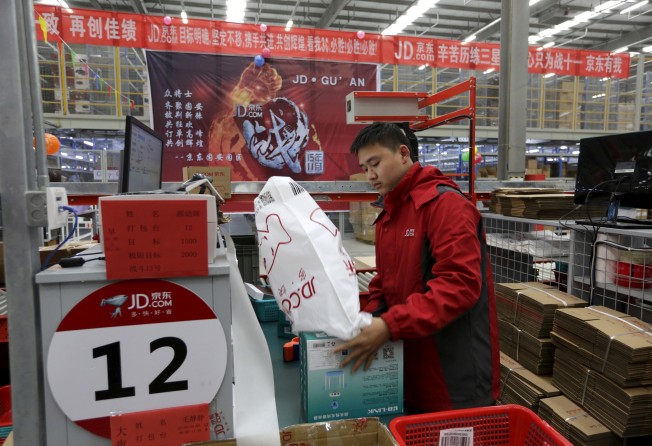With e-commerce booming, investors should make space for Asia-Pacific’s biggest warehouse landlord
- ESR Cayman, expected to be Hong Kong’s largest initial public offering so far this year, will benefit from high prime logistics yields in Asia-Pacific, growing disposable incomes in China and India, and government support for the logistics industry

This is hardly a propitious time for what is expected to be the largest initial public offering on Hong Kong’s stock exchange so far this year, and the biggest real estate IPO since the debut of Dalian Wanda, the mainland developer, in December 2014. The Hang Seng Index is down more than 10 per cent since May 3 as part of a broad-based sell-off in equity markets, with traders fretting about the economic impact of the renewed escalation in the US-China trade war.
Yet the prospectus for ESR Cayman – the world’s largest Asia-focused logistics property developer, which is seeking to raise HK$9.76 billion (US$1.24 billion) in a sale of shares expected to be priced on June 12 and begin trading on June 20 – makes a compelling case for investing in industrial real estate in a region benefiting from strong growth, a rising middle class and a booming e-commerce market.
ESR was formed in 2016 from the merger of e-Shang and The Redwood Group – the former was a mainland logistics developer established by Chinese property entrepreneurs and US private equity fund Warburg Pincus, while the latter was a logistics real estate firm focused on Japan and China.
It builds and manages modern logistics facilities in China, Japan, South Korea, Singapore, Australia and India. Its platform is the biggest in the region in terms of gross floor area, the value of the assets under management and the pipeline under development.
This gives potential investors exposure to a diverse group of mature and emerging industrial property markets in countries that account for 90 per cent of the Asia-Pacific region’s gross domestic product. What is more, it allows investors to tap into a thriving e-commerce logistics market, which accounted for 43 per cent of the global market last year, almost one-third larger than North America’s share and nearly double that of Europe, according to ESR’s prospectus.
Demand for e-commerce logistics real estate, such as last-mile fulfilment facilities, is being driven by China, the world’s largest e-commerce market, where online shopping accounts for nearly a third of total retail sales. Another key driver of leasing activity is the outsourcing of logistics operations by consumer goods manufacturers to third-party logistics providers, which design and manage supply chains.
In Beijing’s industrial property market, demand from e-commerce and third-party logistics operators drove up rents by an eye-popping 22 per cent year on year in the first quarter of this year despite the largest quarterly increase in supply since 2006, a report published by Jones Lang LaSalle last month notes.
Yet it is not just the rapid growth of online retailing that makes logistics one of the most sought-after asset classes in global real estate right now. The sector ticks the right boxes for investors at a time when prices for both commercial and residential property in many markets are sky-high and when concerns about global growth are intensifying.
There are three reasons Asia’s industrial real estate market is best placed to withstand the current headwinds and deliver strong returns over the medium term.

First, prime logistics yields in the main cities across the region are the highest in the sector globally, despite having compressed significantly over the past several years.
Yields in Melbourne, Seoul and Singapore stood at between 6 and 7 per cent at the end of last year, compared with roughly 4 per cent in the main logistics hubs in Europe and North America, according to data from CBRE, another property adviser. Even in Tokyo, where yields have fallen to just below 4 per cent, the spread over government bonds is among the highest in the sector globally because of Japan’s negative interest rates.
Second, logistics real estate in Asia is likely to prove more resilient to the economic fallout from the trade war – central banks in Australia and India were forced to cut interest rates last week mainly due to the escalation in trade tensions – because of the strength of the region’s domestic markets.
The increase in the number of middle-class households, especially in China and India, and the growth in disposable income create significant demand for new warehouse facilities in inner-city areas. The scope for developing modern sheds for lease is huge given that most of the stock in the region, notably in Japan, is owner-occupied.

Third, and arguably most importantly, Asia’s logistics property sector has the region’s governments firmly on its side. Investment in transport infrastructure is a priority for many countries, especially India and China. In 2017, India’s government granted the logistics sector infrastructure status, making it easier for developers and investors to raise capital.
In China, the recent shift to growth-supportive policies has led to a renewed surge in spending on infrastructure, notably urban and consumption-related infrastructure, supporting the growth of logistics hubs.
ESR may be coming to market at an inopportune time sentiment-wise, but its business has a lot going for it. For investors seeking exposure to Asian commercial property, ESR’s offering may be just the ticket.
Nicholas Spiro is a partner at Lauressa Advisory